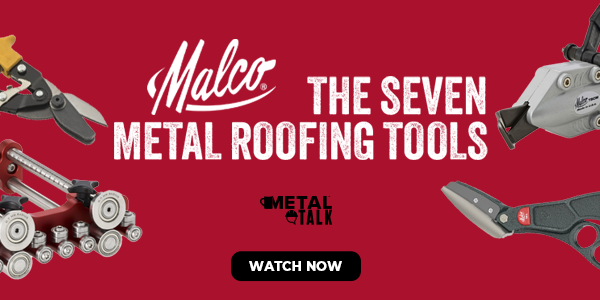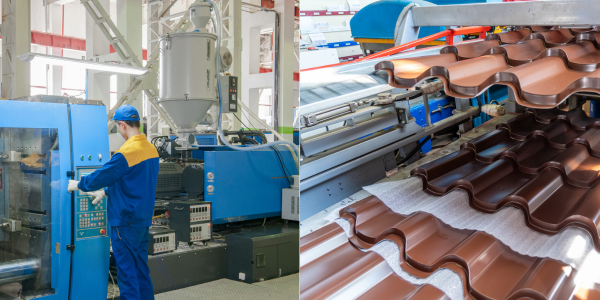UP TO THE MINUTE
The Seven Metal Roofing Tools! - PODCAST TRANSCRIPT
March 15, 2024 at 12:00 p.m.Editor's note: The following is the transcript of an live interview with Jon R. Olson of Malco. You can read the transcript below, listen to the podcast or watch the video.
Karen Edwards: Hello everyone. We're gonna get started here in just a second. We're gonna let you have some time to, uh, hop on and then we'll dive in. All right. Hello and welcome to today's Metal Talk from Metal Coffee Shop. My name's Karen Edwards, and I'm really glad that you guys are all here today for this, because we are gonna be talking about all about metal tools with our friends from Malco Tools. Um, just a few housekeeping items. This is being recorded. It's gonna be available on demand on Metal Coffee Shop, uh, dot com within 24 hours. So, you can share it with friends, colleagues or anyone else who's crazy about tools and just couldn't make it today. Um, we do have the chat open. Um, so feel free to, uh, say hi, share who you are, where you're from, um, and if you have questions, please drop them in the chat and we're gonna take questions at the end. Um, and I wanna thank everybody for being here today to talk about tools with Malco Tools. Move this slide. Here we go. Um, joining us from Malco Tools today is John Olson. John, welcome.
Jon R. Olson: Hello and thank you for that intro.
Karen Edwards: Sure. So tell us a little bit about yourself.
Jon R. Olson: So, my name is John Olson. I'm the learning and product training manager at Malco. I've spent the last six and a half years, uh, connecting pros with tools. So I've worked in a few different positions, all of which work with voice of the customer, uh, really trying to get to the bottom of what tools and what solutions are needed out in the field for the skilled trades that we serve, uh, both HVAC and Roofing side and Gutter Trades. And so it's been really, um, a great opportunity to work with a lot of different people and better understand what tools are really needed in the trades.
Karen Edwards: Wow. Well, we're glad to have you here. And right before we dive in, can you tell everyone a little bit about Malco Tools and maybe the history?
Jon R. Olson: Yeah. Awesome. So, Mark Keer was a young steel salesman back in 1950, and Mark observed through sales calls and, you know, similar interactions that the new round ducks that were being created and used in the, uh, HVAC space, they needed to be, uh, altered in length on site, and there really wasn't a way to crimp them on site. So Mark actually developed a five blade crimper that allowed trade pros to in the field quickly and easily, uh, through cycling a set of handles crimp round duct. And so that really was the inception for Malco. And since then we've been working to engineer solutions, achieve results and respect others in doing so. Um, we really do lean on field feedback through field research and interaction at shows and other events to better understand what kind of value do these trade pros need in tools so that they can do their job better.
Karen Edwards: I, yeah, I like that you said that, um, all of your roles have been involved with voice of the customer and you guys aren't just making tools because you think somebody might need it. You are listening and talking to folks in the trades and then delivering the tools that they wish they had.
Jon R. Olson: Yeah. And right now, I mean, we bring it to the training as well, talking with them about what they need to learn about with the tools. So we, we really do try to take that external feedback and incorporate it into what we do every day.
Karen Edwards: All right. Well, let's dive in. So let's talk about why the right tools are important, and there's some key points here that, that we wanna go over.
Jon R. Olson: Yeah. So safety of course, is top of mind for anybody that's out on the job site. Not only is it a cost of business in terms of liability, but it also is just a great reason to do the right thing, uh, is being able to go home and work with your friends and family doing the things that you love. And so a big part of quality tools is providing safe solutions that are gonna respect, you know, the force that your hand can produce and irregular, uh, regimen. The making sure that the proper, uh, details are created is a great, uh, piece of performance that everybody expects out of their tools. A great example would be a nail slot plunge for vinyl siding. If you don't have a nail slot, that vinyl siding's gonna pucker and flex and it's really gonna make for a nasty looking install.
But simple tools like our nail slot punch, allow that to be a proper install just like factory, wherever you need it. And then of course, quality, we strive to make sure that we produce high quality tools and that's not, you know, necessarily providing the Ferrari that's making sure that you've got kind of that Toyota way of high quality, consistent, um, outputs of, you know, the same tool every time so that people know that when they go to get a Malco snip or they get, you know, whatever tools they prefer, they're getting exactly what they need when they need it.
Karen Edwards: I like the, um, analogy to cars, you know, it's reliable, it's dependable, it's good quality, it's gonna perform and it's not gonna let you down, right? Because you're, you're, you want the right tools so that your installed does not look, um, a mess, right. And that it is good quality. So. Awesome. Well, let's dive into the next tool or the first tool I guess we're gonna talk about here. Um, standing seam, mechanical seamers. So tell us all about this.
Jon R. Olson: So, as we've embraced talking with people out in the field, we've come to understand that in the standing seam market, a lot of people have been renting their tools and so they really have kinda lost control of some of the scheduling, and they're really, you know, having to be a lot more thoughtful about when and how they work on stuff. And so, excuse me, last spring we actually launched a standing seam mechanical seamer that is drill assisted. So you're gonna use your cordless drill to power this tool, and you're able to close a one stage or two stage lock in one pass depending on how many of the five stations you have at play. And so, with the remote trigger, you can stand up and walk alongside it and you're really able to just get to work. Nobody wants to be messing around with the seeming process. It really needs to be, uh, a high quality consistent finish. And that's what we strive to provide with that tool.
Karen Edwards: Wow. So I heard you say remote, remote control. Um, so you're not, you're not bending over?
Jon R. Olson: Yeah, no. It, uh, actually has a trigger system similar to a motorcycle or a comparable, uh, hand trigger that are gonna allow you to run it from a standing position. When you look at this tool, at first you're like, Hey, yeah, that's, that's a great tool, but until you get that trigger at play, you're basically crawling out along a roof deck. Nobody wants to be crawling around a roof deck. So we provide that capability with this tool to stand up and walk alongside it. A lot of people are gonna, uh, walk the roof pretty briskly with this because it's one of the fastest tools in the market as far as being able to seam, uh, 98 feet per minute. That's a pretty quick clip. So it is nice that it is a variable speed seamer as well. So if you wanna modulate the throttle and kind of slow your pace down, you can do that.
Karen Edwards: That's fantastic. Now, looking at that, how, how much would that weigh?
Jon R. Olson: Less than 32 pounds.
Karen Edwards: Wow.
Jon R. Olson: So you're, you're talking, you know, a, a really light package to bring up onto a roof deck. When I've talked with contractors at trade shows, a lot of time they're thinking they can put that into a backpack along with, you know, the drill and be able to go up, you know, using a three point, um, point of contact, uh, process to get onto the roof deck with the ladder system. They're not putting themselves in harm's way. Uh, very easy to carry and definitely something that's manageable for one person.
Karen Edwards: That's cool. Very cool. Portability is important.
Jon R. Olson: Yeah.
Karen Edwards: All right. Our next tool, standing seam cutter, um, similar, the drill attaches right to it. So, to guide us through this tool.
Jon R. Olson: Okay. So our standing seam cutter is one that gets a lot of attention when we go to shows with it. The reason being, it cuts the seam completely off of the roof. And so, if you get a callback and let's say there's hail or substantial tree damage and you've got a few panels that need to be removed or even the entire roof system, you're easily able to cut that roof system off utilizing the standing seam cutter. It uses a slitting pair of slitting blades that just slice through the material just as clean as a tin snip would, and really is a lot more efficient than some of the other means. We've talked to people that are using cutoff wheels and, uh, saw all blades. Some people are unfolding the material and effectively opening up the can, if you will. A lot of people will, uh, in slang terminology call this a can opener and it's, it really is a lot like opening a can. Um, you're gonna start the tool onto the roof deck, and if you wanted to, if you happen to have the seamer and the remote trigger, you'd be able to walk alongside this product as well and just go along the roof deck and cut it off.
Karen Edwards: Wow. So, it really simplifies that whole process for the contractor.
Jon R. Olson: Definitely. It cuts right through the clips e everything needed, so,
Karen Edwards: Wow. So why wouldn't you want one if you're installing metal? Right? This is why this tool is on this in this webinar, um, because these are the seven, the, the top ones that, um, we think you should have. And Malco, um, has talked to contractors who want them. So let's move on to our metal benders. This is kind of new, this is new for you guys.
Jon R. Olson: Well, we're going on over a decade with the three station me metal bender. Okay. So our ER three is our kind of OG of, uh, beers. We got into that business with a three station roller. The three stations were really nice, uh, for the folks that embraced that because it allowed two stations to stay on the metal for a wider variety of, uh, edge conditions. And so a lot of times when you roll a bender over the edge of the panel, it can become a little unwieldy. The three station bender kind of keeps everything in control. However, it is quite heavy relative to the other models, and we just have a far greater breadth of offering with the other models where the contractor's able to make short, curved or straight bends with our one station vendors. Our two station panel or two station vendors are great for forming long eve bends and things of that nature where you've gotta have a long continuous bend. And any of these tools are great because they can make an infinite length bend, whereas a break is gonna be, you know, typically infinite depth or limited depth on the field break end of things. So,
Karen Edwards: So, would this be, um, a contractor would use this like on the job site?
Jon R. Olson: Um, that's for sure.
Karen Edwards: Uh, on the ground, right?
Jon R. Olson: Yep. On the ground or on the roof deck. So a lot of times they're gonna cut at least two panels per face of the roof to center the, the roof material on the field of the roof. And so those rake edges are then gonna be bent, depending on your edge detail for your fascia, you're gonna end up either bending a hem down and clipping around it or you're gonna bend a m up to a 90, um, in a vertical direction. And you're gonna put a detail that wraps around that. So really a handy tool there. There's a minimum of probably four panels per roof that do need to be adjusted and width. And these tools give you everything you need to be able to do that. You can even profile panels, so create your own custom, uh, width or angled tapered panels if you need to on site giving you the ultimate and flexibility.
Karen Edwards: Wow. Yeah. That's cool. Um, you make your own and, and it's infinite lengths, you can just go on and on and on and on however long you need, right?
Jon R. Olson: Well, yeah, it, it really can allow you to step up your game and it comes to your details because then all of a sudden, you're putting long continuous details out instead of messing around with splicing details together. So that's huge. When you're talking about aesthetics and giving a cons consistent look and feel throughout the exterior,
Karen Edwards: How, um, how easy is it to learn how to use?
Jon R. Olson: You know, there's a bit of nuance to it, but it's fairly easy. I would say most people are gonna wanna practice a couple times before they really try on some finished details. But, um, the main thing is learning how to grasp and hold the tool. And then a lot of times you're just applying a very light amount of pressure in an upward direction to create a crease. Once you've created a crease, then you can start rolling back and forth. The biggest thing for people to learn is that they can't make the fold lull at once. So with a seamer or a folding bar, you're gonna effectively just grab the part and you're gonna bend it. It's gonna be a very quick process. This is a little more nuanced where you're just gonna roll back and forth, back and forth, back and forth until ultimately that material is bent to where you need it to be.
Karen Edwards: Okay. So we've talked about benders and, um, we're gonna move on into snips, um, and having the right snips for the job is really, really important. Can you tell me about the different kinds and why they, you know, the benefits and features of them?
Jon R. Olson: Sure. So we've got snips for every job. The mini snips that we sell are a very small miniature snip that are great for service calls and, you know, emergency packs that some people like to have in their truck or trailer to be able to quickly go out to job sites where they're not really sure what they're gonna find. But mm-hmm, they, they would just want something on hand. Then we have, um, a full line of aviation SNPs, which for us includes our M 2004, which is a double cut. So that M 2004 allows you to cut up and over the profiles that are common in, uh, vertical seam metal roofing. And so that really quickly can cut whether it's right or left cuts that you're needing. All the scrap goes up through the center of the cut, and so you end up being able to cut in either direction, a nice straight cut over the full 180 degree bend. And so if you're setting up drip edges, that can save you a lot of time and energy by simply just following the shape of the profile up and over, and then coming in from the end to cut that section out.
Karen Edwards: Okay. So, um, you, you mentioned, um, about swapping lefts and rights, and it's kind of, you don't need to do that anymore.
Jon R. Olson: Well, if you're using M 2004, yeah, you don't need to. But for proper cutting of metal, a left snip and a right snip are imperative. Um, what I mean by that is a left cut snip is gonna curve to the left and anything on the left side of the blade is gonna be the finish cut. So that's where your really nice looking cuts are gonna reside. A left, uh, right cutting snip is gonna do the same thing and it's gonna curve to the right. Uh, typically a lot of people are gonna favor a left cutting snip and we have our aviation snips and both right and the left snip and then we have our, uh, Andy's, uh, line of snips both in a standard as well as our offset Andy, which is our mc 12 L in an offset left cutting snip. So that's a great snip because it's offset and it keeps your hands out of the way of the flow of the material, and you can really easily cut radiuses with it that are very small, and you can also cut long continuous pieces such as breaking down a full sheet without having to have your hands in the way.
Nobody likes to get cut by sheet metal. Oh, gosh. And offset sniffs make it a lot easier to avoid that. Yeah,
Karen Edwards: Yeah, for sure. Um, so tell me a little bit about the, um, turbo shear and how that came to be.
Jon R. Olson: All right. So through some of our innovation process back in the early two thousands, the turbo shear was created. And so we definitely observed that in the trades, people have to cycle their hands multiple times in order to create a cut, right? And most contractors have some form of a driller driver on hand at all times for installing screws. So the concept was simple power a snip using a driller driver. And so the turbo shear really came from that simplicity of trying to take a few things that are known and needed and putting them together. And so now we have, I wanna say, in our 20 years of turbo shears, we were pushing nine different SKUs. And so that's a really fun stat is we've celebrated this year, 20 years of turbo shears, and we have 'em for corrugated metal, we have 'em for just standard flat metal. We've got natural slate fiber cement, vinyl siding and uh, double cut shears that can also cut, uh, a thin ribbon strip out of the center and allow two finished cuts on either side,
Karen Edwards: And it just attaches to a driver or a drill.
Jon R. Olson: Yeah, you're really quickly gonna chuck up the drive shaft. And then as you're seeing on the screen, there's the black arms that are gonna fold around the driller driver. And so those are gonna slide or, uh, adjust to whatever size driver you need. And really, it just, it takes so much of the strain off of a person's forearm. A lot of times people will get to a point where they have to cut across a panel and the TSCM is a great tool as you're seeing in the image on the screen because the angle of the blades is substantially higher than some of our other tools. And so it allows you to get up and over the peaks and valleys that a corrugated metal piece would have present when you cross cut the panel.
Karen Edwards: Wow. Yeah. So that's saving a lot of the, the, the repetitive actions and like you said, the not as much weight and pressure on the forearm. Um, so yeah, I, who wouldn't love a turbo share. Right,
Jon R. Olson: Right. And safety is a big deal. We want people to be able to go home and celebrate life with their families and just live it.
Karen Edwards: Yeah. Yeah. And I think, you know, having the, like the, we, we talked in the beginning about quality and I think having the right tools, the right snips, like something like the turbo shear, you know, that that's less effort that's gonna give you those clean cuts, that's gonna give you a nice finish, um, product. That's, that's what every contractor wants and as well as every customer out there. Right?
Jon R. Olson: That's right.
Karen Edwards: All right. So importance of that. Now, you mentioned drivers before when you said most contractors have a driller a driver around. So tell me about your hex drivers.
Jon R. Olson: Yeah, so our hex drivers, we started off with a fairly basic line of single piece hex drivers. A lot of people are familiar with the, uh, quarter inch MSH is what we call 'em. Uh, most people are gonna call 'em a hex truck or a hex driver. Um, we've had a really high quality line of, uh, single piece drivers for a while now. People love 'em because they're typically harder than some of the competitors, so they don't wallow out as easily as some of the competing product. We innovated on that and created an impact blue version, which actually has a, a magnet that's spring loaded and the magnet stays in contact with the screw at all times, whereas most magnets are gonna be spaced away from the screw. The nice part with the spring is it's so, such a light spring action that it allows the rim of the fastener to contact the outer perimeter of the socket and that then ensures that the fastener spins true.
You've gotta think of it as a karate chop. If, if the karate chop is far away, it's really gonna hurt. If the karate chop is always following the target, it's really never gonna make contact that is destructive. And so that's the theory behind that impact blue line of drivers is really just making sure those karate chops can't occur on that magnet. Uh, a really fun, uh, component of those single piece drivers is that when you're doing production type work where you're installing hundreds and hundreds of screws, they're gonna stay together in one piece and be exactly where you need 'em to be. But that opens us up to what's on the screen, which is our two piece drivers. So we have quarter and five 16 drivers and our building construction line that if you are not doing, you know, a full on install of a through fastened roof, we highly checking out because they have a quarter inch and five 16th inch sizes all in one. And because the reversible socket can be removed, it allows the magnet to be cleaned. And that way, if you're ever having issues with debris, you just clean that magnet with a quick swipe of a shop towel or a, a gloved hand.
Karen Edwards: So—
Jon R. Olson: What we also have our sawtooth line, which takes that a step further. So if you've ever been on a roof deck, Karen, where somebody's came through and tried to seal all the fasteners.
Karen Edwards: Yes.
Jon R. Olson: Oh my goodness. Uh, working with some of your coatings companies, it's interesting to see and better understand what some of these solutions have come to be. Uh, I know there's one solution for sure where, uh, every screw ends up being caulked over with a dollop of, uh, adhesive Mm-Hmm. And if you ever go to remove one of those roofs, you actually have to scrape away all that sealant. So our C rec saw tooth allows you to cut away that sealant without having any additional tools. And the nice part with it is you can actually clear out the driver by flipping around the drive shaft side of the socket or the shaft and pushing any slug of material right out of the socket so you're quickly and easily able to get back to work.
Karen Edwards: Wow, that's brilliant because yeah, there, there's a lot of fasteners and a lot of that adhesive and gunk to, to clear off that's gonna save a ton of time.
Jon R. Olson: People are pretty excited when they see that solution. Yeah,
Karen Edwards: Yeah. Yeah. And that's why we're talking about it today, because you need to know that that's an option and, um, man, game changer in terms of labor. Right,
Jon R. Olson: Right.
Karen Edwards: Okie doke. Um, next, um, you've got an adjustable siding gauge and, um, I, we talked about this the other day when we were reviewing for this presentation, and I, I was really impressed with this and I think people are just, well, they probably love it already, but go ahead and tell us about that, John.
Jon R. Olson: Yeah, so this is another great innovative product that we leverage market research for to better understand, you know, what are people wanting out in the market. And our research showed us in interactions with not only contractors, but distributors also, that it's kind of a pain to have to select a different gauge for every type of siding that you hang. And so our goal here was to create one tool that would allow you to hang any of the lap siding available on the market. And we really hit that need by allowing a clamping adjustment to take place out in the field. And you can quickly and easily adjust for the size of the plank that is being used. So we can hang anything from a five 16th thick, uh, hardy board to a five eighth of an inch thick fiber cement siding board. And so you're talking some really substantial, uh, variation and thickness and weight and the clamping being adjustable allows you to make sure that you're ready for whatever job is quoted that week.
Karen Edwards: Yeah, yeah. And now you talked about, um, when you were doing some field research for this, what were, you know, before this you developed this tool, you were, you were seeing contractors u using duct tape. Right. And what, you know, what were, what were their frustrations that you, that you found?
Jon R. Olson: Yeah, so there's a competing product to this, and you can't adjust the cam mechanism that they use to climb onto the product. And so there were people using shims and cardboard and, uh, duct tape, anything they could to try and extend the life of their tool. Well, because, you know, any rubber is gonna slightly break down over time the clamping mechanism was breaking down. And so part of the benefit of this tool is because you can adjust it, you can really just adjust out any wear and tear that may occur and over the life of the tool. So you end up extending the life of the tool and allowing, you know, contractors and distributors alike to only have to worry about one tool instead of multiple.
Karen Edwards: Yeah. And that's good, you know, because space is a premium and, you know, you go only, only have so much space in your truck or in your toolbox. So not having to have multiple, multiple types and sizes. Wow, that's very convenient.
Jon R. Olson: Definitely a helpful tool.
Karen Edwards: All right. Now we talked, um, earlier, briefly on how, you know, how hard is it to learn to use the vendor or to use these tools. Talk a little bit about how, um, you know, you guys support the, the contractor in not only learning how to do it, but to do it correctly to ensure that how quality job.
Jon R. Olson: So, we've got a few different ways of doing that this spring. We're actually gonna get out to some of our distributors and we're gonna be showcasing the products, uh, onsite at those distributors. Uh, we're, we're calling 'em food truck events, but really it's just outreach to make sure that, you know, when we go to these areas in, uh, North Carolina, Tennessee, uh, Philadelphia area, uh, we're gonna be able to meet with those contractors when they're coming in to get orders for the week and make sure that they understand what some of these tools can do for them so that they can ultimately improve what they're doing for their daily. We want them to purchase stuff that's going to produce value for them. So that might allow them to meet the demands of their job easier, that might allow them to cut out a little early that day and go spend time with family, whatever that might be.
Karen Edwards: Yeah, yeah. Now you, you, you called it food truck events. Do you serve food there?
Jon R. Olson: At a few select shows we will be. Okay. Um, we're also gonna be going to a variety of trade shows throughout. Uh, one of the events that we love going to is Skills USA, where we're gonna meet up with educators and students from the industry. Uh, we typically sponsor the sheet metal competition there, as well as the teams event. And so some really neat stuff for the building construction trade where these high schoolers and collegiate students are working on showcasing their skills and abilities.
Karen Edwards: Yeah. Yeah. And you, um, you, so you'll be at Skills USA that's in Atlanta, um, I believe it's the end of June. Um, and then you'll also be at the Florida Roofing in and Sheet Metal Show. Um, that's in June too early June.
Jon R. Olson: Yep. So our team will be at the Florida Roofing Roofer Show, and we'll be showcasing some of our products. We'd love to have you stop out to the booth and get a demonstration or a hands-on trial of some of the tools. Love to put these tools in people's hands when they stop into the booth so they can feel 'em, articulate 'em, make sure they feel like they're the right tools for what they need on the job.
Karen Edwards: Yeah, yeah. Try, kind of try it before you buy it. Right,
Jon R. Olson: Right.
Karen Edwards: Um, so let's move on to talk about some of the professional programs that, um, you guys do. You, you mentioned Skills USA and, and sponsoring the, the Sheet Metal Competition, that that goes on there. And that, that's such an impressive event and an impressive organization. And if, if anyone ever has an opportunity to, to go and check it out, um, it's really, really cool to see the young, the next generation right, of our workforce, um, competing in, uh, you know, they build a literal house there at the event that there's so many cool things happening. Um, but you have a program, uh, called Head of the Class that, um, I just learned about recently, and I am a big fan. Can you please explain what this is and how it works?
Jon R. Olson: Yeah, so our head of the class program empowers educators to award a student in their classroom as the head of the class. And so talking with instructors that might be, you know, whether that be the most improved student, the student that showed exemplary skills, whatever that might be, we really don't judge for those reasons. We are empowering those educators to go out to our website, click on our educators page and submit some information about the head of the class winner as well as the rest of the classroom. And then we send out, um, a prize to the, the winner as well as the rest of the class receives, um, a hat, a driver and some catalog information so they can really start seeing what tools are used in these trades that they're going into. We ultimately wanna meet those students where they're starting their career and make sure that they are rewarded for doing a good job.
Karen Edwards: So, if any of you on this webinar are working with any of your trade schools, your tech schools, community, college, anyone that's got any kind of HVHCC Yeah. H-V-H-C-C, um, that, you know, that let them know, let the teachers and let the schools know about this program because I think it's just, it's really cool. And then, you know, there's no cost to the, to the teacher, to the class. This is all donated by Malco. Very cool. Definitely. Okay. What is the Trade Pro of the year?
Jon R. Olson: So, we put together the Trade Pro the year to recognize approximately five per category trade pros that are showcasing the core values and really just are exemplary in the trade, uh, that Malco has been pushing. And so what we love about the Trade Pro the year is it's recognizing people that are professionals that are not only, uh, showing great work ethic and stuff out on the job site, but also, uh, enriching their community in ways such as philanthropy or other things to try and make sure that, you know, they're living a good life and showing a good, uh, version of the trades so that more people are interested and, you know, basically living that same life. We want people to be excited to be in the trades and excited to be a part of that. And the Trade Pro of the Year is part of how we recognize those individuals.
We take nominations, which can be self-nomination or otherwise, and those five contestants are pulled out and win a thousand dollars in Malco Tools. So, we just wrapped up at the end of the quarter here, our Trade Pro, the Year for Roofing or our building exteriors, but we have our HVAC Trade Pro the year running right now. So, if you know an HVAC trade professional that you believe would be, uh, a great contestant for Trade Pro of the Year, by all means, please go to our website, click on Trade Pro of the Year and get 'em registered because we wanna recognize 'em for doing a great job.
Karen Edwards: And this is, this is every year, right? So Yep. Even though the Building Exteriors Professional just closed, it'll reopen again, um, toward the end of the year, right?
Jon R. Olson: Correct. So you'll definitely want to check that out. Um, definitely put, put the time in to nominate yourself or somebody else on the job site that you believe is, uh, ex exuding that head the class or that, uh, top Trade Pro style that you would expect.
Karen Edwards: Yeah. Yeah. And don't be afraid to nominate yourself, right? That's right. Um, people, you know, we, we, we do good things. We, we volunteer, we give back and then we don't really wanna talk about it because we don't wanna sound like we're bragging or, but you know, as you mentioned John, uh, just elevating the whole professionalism of the trades, whether that be building exteriors or HVAC, that that's just one, one small part of it. Um, you know, the, the, the construction industry in general I think is a very giving and, you know, we, we always have stories about someone donating a roof or, you know, whatever volunteer service they're doing. Um, we wanna share that and, um, we wanna be recognizing folks for it. So I think it's just fantastic that you guys do this every year. And who doesn't wanna win Free tools. Right,
Jon R. Olson: Right.
Karen Edwards: Okay. So, if I'm not gonna win free tools, I can certainly buy myself some tools. So let's talk about how to get the tools.
Jon R. Olson: Yeah, definitely. So, if you go to Malcotools.com, you can use our distributor finder to help you find a distributor near you. Any of our distributors are able to order in whatever is available in our tool catalog. So go to malcotools.com, uh, either check out or catalog so that you can conveniently find what you want on your wish list or just go to the local distributor that you find in your area. Um, you can definitely also go to amazon.com and check out Malco tools there, and you'll be able to see a lot of the tools in our selection there. But definitely check out the catalog, work with your local distributor, whether that's an A, BC supply, an SRS or a smaller mom and pop that's maybe a metal farmer in your area.
Karen Edwards: Okay. So lots of options and it's nice to hear you're on Amazon 'cause we all want it now. All right. Once you decide that you want it, you wanna get it now. Well, this has been really, really interesting conversation, John. Um, I, I, we've got some, some folks out there that may have questions, please drop them in the chat and, um, we can get those answered for you. Um, I, all right. Am I back?
Jon R. Olson: You appear to be Okay.
Karen Edwards: I'm sorry, I froze for a minute. Good old internet. Um, and, and I don't know if you heard me ask this last question, but I wanted to know if you'd be willing to share what your favorite tool is and why.
Jon R. Olson: So, my favorite tool is the Turbo Shear because when you think about a tool that is gonna reduce the wear and tear on a person, and our line to me that turbo shear is that tool, uh, you really can just, instead of messing around with a hand snip, you can go straight to that powered solution. And the beauty of it is you're not adding a bunch of, uh, dedicated tools because it works off of your driller driver. You're gonna use that same battery and, you know, uh, drill assembly that you're using for the rest of your job. So it just simplifies things and makes life a lot easier,
Karen Edwards: Keeping it simple. Well, there you have it. Um, I don't have any questions right now, but just to, to recap, you know, it's the, the, at the beginning we started off with the, the why, why the right tools matter and it was safety, it was performance, it was quality. And at the end of the day, you know, you want to have that job. We're, we're craftsmen in this industry, right? So you, you want to, to accomplish a job and, and be able to be proud of that and have a, a customer that's happy and, um, you know, that, that it, everything looks beautiful, no callbacks, right? And the right tools can help you do that
Jon R. Olson: For sure.
Karen Edwards: All right, well thank you everyone for being here today. Um, it was great to have this conversation about tools and, um, join us each month. We do this once a month on Metal Coffee Shop with different topics, and be sure to follow us on social media so that you don't miss a thing. And please share this, uh, webinar with anyone that you think might be interested in learning more about Malco Tools. Thank you all for being here. Thanks, John.
Jon R. Olson: Thank you.





















Comments
Leave a Reply
Have an account? Login to leave a comment!
Sign In